Churches and Cathedrals of Madrid

In Madrid, the influence of the catholic religion is still today clearly noticeable. Even though many people do not any more visit the church service regularly, today, there are daily up to three short church services in many churches. Those who are not under pressure of time, should take the opoortunity to visit a spanish church service.
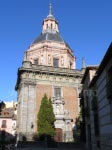
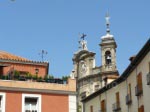

Most of the times, the churches are opened in the mornings and in the evenings at approximately one hour before the church service begins, a thing that could be used for a short viewing. As it is the case in all churches, respectful behaviour and adequate clothing is a matter of course; Even if it is underestimated many times - the reaction of the local people to the adaption of the visitors is very positive.
The following overview about the churches in the centre within walking distance is only a selection of the numerous churches of Madrid. For those who only want to pick out only a few buildings I highly recommend the cathedral Nuestra Seņora De La Almudena, the church San Miguel and the Iglesia San Andrés.
Catedral Nuestra Seņora De La Almudena
The cathedral of Madrid, named after the patron saint Almudena. In the proximity of the subway station Opera (L2, L5),located beside the Royal Palace, one cannot miss it, as with the palace, it is one of the most important attractions of the visitors of Madrid.
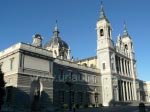
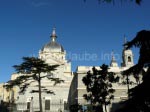
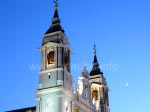
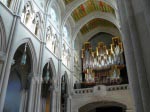
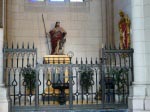
Contrary to the most churches of the city, it was built relatively late; the building took place in the 19th century and ended in the year 1993. Many Madrileneans reacted in a very sceptical way when the construction works of the cathedral Ntra. Sra. De La Almudena was finished and preferred to continue visiting "their old" church for the church service. But since the marriage ceremony of Prince Prinz Felipe and Letizia, the cathedral was increasingly accepted; Nevertheless, the neo-gothic cathedral does mainly arttract tourists.
The two towers that are facing the Palacio Real are, compared to the rest of the shape, quite narrow. Those whose preferred buildings are baroque churches will probably be disappointed by the Almudena: gothic elements like the typical four-centred archs as also the indescribable height set a couse; otherwise, the style of the chatedral is really simple, a thing that certainly provides an elegent touch. The light grey colours dominate and enforce this effect.There are a lot of side chapels with altars and paintings. The dedications to the Virgin Maria and the death of Christ are specially noticeable. From time to time, some organ and piano music emerges silently in the background, a thing that invited to reflect despite of the numerous visitors.
Colegiata de San Isidro
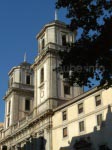
The Colegiata de San Isidro was already built in the 17th century and was the cathedral of Madrid before the.Catedral Ntra. Sra. De La Almudena became the cathedral of Madrid. It is located in the Calle de Toledo, from the tube station La Latina (L5) in direction to the Plaza Mayor. Situated in between other buildings and relatively insconspicious from the exterior, its interior is a baroque piece of art for which interior's arrangement money was not an issue. The golden decoration appears - as also as the rest of the arrangement - less religious but more artful. The few church statues strengthen this impression.
Even if the art treasures of the interior did not survive a fire of the Spanish civil war, the significance of the collegiate church remained: in it, San Isidro, the patron saint of Madrid, rests. His remains are carried through the streets on May 15th of each year in procession.
Iglesia Sta. María
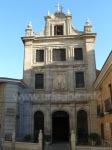
Located at the Calle Mayor (subway station Sol (L1, L2, L3)), the Iglesia Santa María does not appear, contrary to other baroque churches, overcharged but just the opposite, very classy. The main altar with its two powerful columns and a dark brown-red colour forms an interesting contrast to the gold cladding. Above the altar there is a long altar painting. Two angels floating on the top and look to the centre are praying: to a clowd with golden sun rays and a pigeon that symbolizes God. The symmetric cuppola is very sightly arranged.
In the interior of the church there are several smaller and golden altars visible. The decoration with small angels and children, of which some are dark-skinned, is conspicious - an arrangement I have never seen before in a church but I personally really liked. It is an arrangement that expresses like no other church that, no matter of the colour of the skin, all human beings belong to god.
Iglesia San Gines
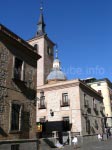
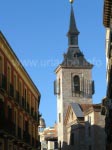
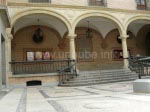
The church San Gines is located at the "Shopping mile" Calle Arenal, close to the subway station Sol (L1, L2, L3). Its entrance appears almost occidental and less catholic. The rest of the building, specially the tower and the construction material confirm the style of Mudejar. The interior is quite simple, but bright and very nicely arranged: discreet candleholders, the altar with black columns and a big painting shape the room.
Due to some destroyings during the civil war, several renovations were necessary, a thing that is probably an explanation for the decoration that strongly differs from the other churches of Madrid.
Iglesia Santiago
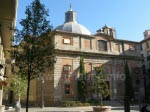
The church Santiago is located at the Plaza Santiago at the subway station Opera (L2, L5) and apeears, either from the outside as also from the interior, to be very generously arranged. It has the tyical symmetric arrangement of the side chapels. The main altar is abundantly adorned with gold; the columns strongly remind on the antique. On top of the altar, there is a big painting with a horseman with a sword who appears to be warlike but still saintly. In front of the cuppola with the main altar, there are some stools where one can kneel down, that are decorated with a cross similar as the one of the knights and that remind a little on the arrangement of the Iglesia Santa Cruz.
In the glass cabinets, there are some small statues that are arranged symmetrically and that attract the views. The hallow Maria with a green dress of cloth is specially conspicious.
Iglesia San Nicolás
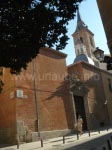
The Iglesia San Nicolás is small and inconspicious and is located close to the cathedral Almudena at the subway station Opera (L2, L5), at the Calle J. Herrera. Its inner arrangement is equaly modest, but this is a thing that makes her appear very homelike and transmit a unique calmness.
The paintings and statues set a course. The relatively low archs and the bright yellow walls enforce the inviting atmosphere: the lostness that one feels in the overcharged churches does not come up here for a second.
Iglesia San Miguel
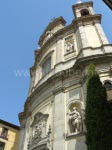
The baroque pontifical church San Miguel at the parallel street to the Calle de Toledo (Metro La Latina (L5) or Sol (L1, L2, L3)) was built in the 18th century by the Italian Santiago Bonavia, a thing that is reflected in the building style, as it is oftenly described as "artful" or "graceful". The cladding of the church is very outstanding, that outperforms semicircular with the two side bell towers.
The interior of the church is arranged with a lot of frescos and sculptures in which creation the brothers of Velázquez contributed. The cuppola shows a sky image and the side chapels of the single naved interior do have some small altars with sculptures. The colour arrangement is very tasteful in white granit and gold, while the cuppola is blue-white coloured; What is specially impressive is the altar painting: a war scene is represented where there are also angels. Above the painting, an image of god is attached in a laurel wreath, who seems to observe the happenings in the painting together with the angels.
Church Santa Cruz
The church Santa Cruz is located beside the Palacio Santa Cruz, close to the Plaza Mayor and the subway station Sol (L1, L2, L3). Strangely, today's Foreign Office of the Palacio Santa Cruz was until the year 1901 the most important jail of the city. Already in medieval times, many prisioners had to pay for their actions with their life - events that took place at the Plaza Mayor among huge crowds of people.
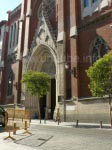
Contrary to almost all the other churches, this church heighted approximately 60m slightly appears threatening. The columns of the interior of the church "Holy Cross" reminds with its height and colour to the cathedral of the holy Almudena. But the style of the Iglesia Santa Cruz is stronger orientated to the gothic building style, a thing that is noticeable in the symmetric, the ogives and the church windows at the upper side of the archs. The side chapels are separated with grids that have some acute golden poniards.
The main altar and the Virgin Maria are represented in a very illustrious and powerful way, as also the organ. The whole arrangement of the church makes one think that in the time the church was constructed, the perception of religion must have been very strict.
Iglesia San Andrés
A beautiful church which should not be missed to be visited is the Iglesia San Andrés on the Plaza San Andrés in the district La Latina, after which the subway station of the line 5 is named. From the outside, it offers a beautiful but not uncommon appearance with its columns, small towers and bricks. But from the interior, one gets a very uncommon view:The main chapel outstands with its grey-golden cladding in a high contrast with the rest of the church. The church is characterized by grey-white marble and terracotta coloured walls. The relativly simple arrangement with plants, candles and individual paintings makes this area to appear very homelike and resident.
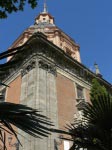
The main altar in the main chapel is surrounded by two side chapels and a cuppola that nearly appears overcharged with its adornment of angels, fruits and plants. In the back part of the church nave there are smaller chapels in which the daily and smaller church services take place. They are more simple but also arranged with an artful high altar.
The whole church has a considerable height and has some high archs. In front of the main cuppola, two statues of Jesus and Maria stand in front of each other that appear very noble and authentic with their cloth robes. Both statues are characterized by dolour; by looking closer, one recognizes the inscripts "María - Nuestra seņora de los dolores" (Maria - Our women of dolour) and "Jesús - Nuestro seņor de la paciencia" (Jesus - Our lord of patience).
Iglesia San Pedro
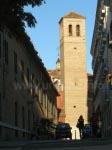
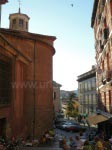
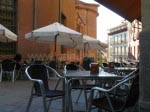
Also in the district of the Latina, close to the Calle de Segovia, the Iglesia San Pedro is located, the first church in which I have seen some ventilators. The wide archs and the dark main arch to the altar, which dark colours are in contrast with the bright rest of the church, are conspicious. The statue of Maria under a kind of column house appears almost antique and is illuminated with candles; the altar painting is nearly not recognizable with normal daylight - the windows over the archs are much too small.
Here are also some small side chapels. The surrounding of the church, specially around the Calle de Segovia is really beautiful and worthwhile seeing.
Real Basílica de San Francisco El Grande
The Real Basílica de San Francisco el Grande at the Calle de Bailén, a few minutes distant form the subway station La Latina belongs, either from the exterior as also from the interior, to those buildings of Madrid that are impressive and "bury" some people with their pomposity".
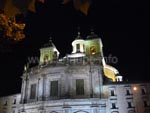

The interior of the Basílica is characterized by the side chapels, a mighty cuppola. The arrangement is dominated by the colours gold and by paintings: the art works of Goya, Velázquez and Zurbarán appear specially often.
The building of the Basílica begun in the year 1761 according to the plans of the Franciscan Francisco de las Cabezas. The building was a challenge, specially because of the cuppola, so that the famous arquitect Francisco Sabatini had an important role:the coordination and guidance of the building. In the year 1785, the neo-classical Basilica was finally completed and declared to the Panteón Nacional approximately 100 years after that; Among others, the arquitects Juan de Villanueva and Ventura Rodríguez rest there.

Back to the index Madrid
Author: Stefanie Kotulla; Copyright 2008-2008: Patrick Wagner, www.tourist-guide.biz
|